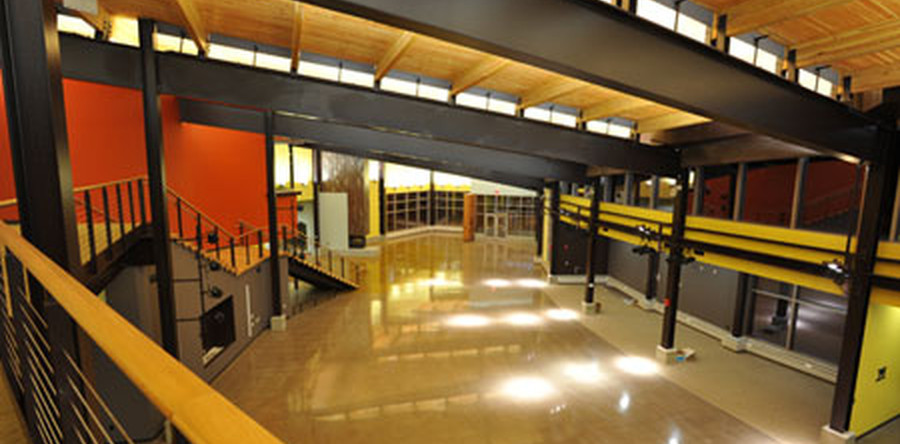School flooring has long been the domain of carpet and vinyl.
That’s changing. Finished concrete floors are showing up in ever greater quantities in schools ranging from elementary to university.
What’s in it for you? Are concrete floors right for your school? Here are points to consider, from those who know.
Areas for concrete flooring
Concrete flooring is ideal for most areas in schools, with a few exceptions and considerations. That’s according to Manufacturer’s Representative Ron Saunders, Saunders & Associates, Bluffdale, Utah. Saunders estimates he’s worked on or consulted on more than 60 schools during his 20-plus years in construction.
Concrete flooring, with its durability, aesthetic potential and low-maintenance requirement, is ideal for classrooms, restrooms, offices, and common areas like lobbies, auditoriums and hallways.
A consideration — some might say drawback — is that areas with hard flooring can be noisy. Saunders calls noise ricocheting off hard surfaces “sound slap.” He notes that auditoriums usually have sound-deadening panels on the walls.
Carpet can quiet noisy classrooms — it just goes on the walls, not the floors, Saunders says. Carpet takes much less of a beating and lasts longer on walls than on floors. Concrete, even colored and polished to a high gloss, is meant to take a beating, so the classroom floor is a good place for it.
Washable rugs, mats and cushions can replace the seating comfort carpet provides children in classrooms, while keeping the considerable advantages of concrete flooring. Rubber anti-fatigue mats can make standing on concrete floors comfortable as resilient flooring for cafeteria workers.
Vocational “shop” classrooms are good choices for concrete floors, Architect Mark Muller, Treanor Architects, Lawrence, Kan., says. And concrete floors are always appropriate for janitorial, electrical and other utility spaces – anywhere there could be wheeled traffic or other heavy use.
All these floors, classroom to closet, at a minimum require dustproofing with a hardener/densifier or film-forming sealer.
Areas not recommended for concrete floors
Muller suggests caution, however, in using concrete floors in school labs where students might handle acids or reagents. Concrete floors in art rooms where dyes and paints could be spilled also take extra consideration.
While concrete is ok for outdoor basketball courts, Saunders says wood is the best choice for indoor courts – but only because it’s traditional.
Kitchens are too spill-prone to make concrete a good floor choice, he says. Concrete is porous and soaks up all the liquid that gets spilled on it. Juices, vinegars and even milk can etch the concrete.
Water- and oil-repellents can afford some protection, but an impermeable surface like glazed clay tile is a better choice, he says. Even then, the grout needs a protective treatment.
Health considerations
The Asthma Regional Council of New England names concrete flooring as a top choice over carpet and vinyl for schools. In the group’s 2005 white paper “Health Considerations When Choosing School Flooring,” author and Certified Industrial Hygienist Frances Gilmore, MS writes “A number of pollutants that are associated with respiratory illnesses, including dusts, mold and mildew, are captured and can grow in carpets and then get released into the air. Vinyl is also subject to mold and mildew when water pools below it. Vinyl is also the most toxic flooring material to manufacture and to dispose of.”1
Gilmore gives concrete floors high marks for being better for health, lower maintenance, higher durability, and having less environmental impact than carpet and vinyl.
Maintenance
Officials in cash-strapped schools must weigh the cost of grinding and other concrete surface prep against simply putting down resilient flooring, Muller says. But eliminating waxing, buffing and stripping can save schools quite a bit of money over the course of a year, a decade or a bond-issue.
That’s a major reason concrete floors are increasingly attractive to decision-makers, Muller said, even though they may be more familiar and comfortable with traditional carpet and vinyl flooring choices.
“Be sure to educate your maintenance staff on that point, too” he added. “Some maintenance technicians are of the opinion that if it’s horizontal and doesn’t have carpet, it should be waxed and buffed no matter what.”
“We wanted polished concrete for the ease of care and reduced cost of janitorial work,” said Lorne Lemay, assistant maintenance manager at St. Matthew’s Middle School in the little Canadian town of Rocky Mountain House, Alberta.
St. Matthew’s has gradually replaced VCT throughout the school with polished concrete, since 2006. Areas include hallways, classrooms, band room and staff lunch room.
“There’s no waxing or stripping. We get ahead of the game with polished concrete,” he said.
One of the great things about polished concrete floors is that you don’t have to train custodians how to wax,” says Principal Gaylon Havener, Central Park Elementary School, Bentonville, Ark.
Havener’s school features colorful, polished concrete in hallways and lobby.
“A terrazzo or tile floor has to be waxed and has to be done by an expert,” he says. “You can’t just get anybody off the street to come in and wax a floor. We basically can get anyone off the street to come in and sweep and run a floor machine and our halls look great. The ease of care is a huge difference.
“We have over 900 kids here, a staff of 100, and probably 100 parents in and out every day. There is a lot of wear and tear on the floors. These floors hold up beautifully. We sweep them twice with a dry duster during the day and we run the floor machine and wash them at night.
“That’s all we do,” he said. “We don’t do anything else.”
Know what to expect
Make sure you understand what you’re getting in a concrete floor before the work begins, says David Stephenson, American Concrete, Springdale, Ark. The best way to do that is to have the contractor create a test panel.
“I had a school district superintendant who was paying under $5 a square foot, but who wanted a perfect $22-$23-per-square foot terrazzo finish,” Stephenson said.
“Instead of telling him right away I could do it, I had the general contractor pour a 20 square-foot sample to the same specs as the 80,000 square-foot slab that was planned.”
Stephenson and his crew then ground and polished the sample for the superintendant. They explained the process as they worked. Though it wasn’t a terrazzo finish, it looked good, Stephenson said.
“We went after it aggressively and exposed a lot of black, white and gray aggregate. The superintendant was extremely satisfied once he understood the process and knew what to expect.”
But no matter how good the job looked, Stephenson said, the superintendant probably would have been surprised, and possibly disappointed if he hadn’t understood the process and seen the sample first.
Environmental concerns
New concrete is usually produced locally, so you avoid the energy consumption -- and the price -- for lengthy transport of heavy rolls of carpet and boxes of tile, Muller points out.
Old concrete subfloors, stripped of worn carpet or failing vinyl, are already there. They don’t even take the limited cost of a concrete transport truck.
Since concrete floors don’t need to be replaced, they don’t take up space in landfills like other flooring types that have to be removed at the end of their service lives, or because of accidents – floods or spills for example. While many flooring manufacturers offer recycling options for their products, concrete stays serviceable for the life of the building.
Are concrete floors right for your school?
“I think our (polished concrete) floor – you know the term now is ‘pop’ – I think it gives us a lot of pop when people walk in,” says Havener. “It’s shiny. It’s bright. We have our logo stained right in the middle of the entry.
“People come in and they get a great first impression of the building. I think it changes attitudes even before they meet the people here. They get a good impression of the school.
“This is my 34th year as a principal,” Havener says. “I started out in a building built in 1915 that had oak floors. I’ve had carpeted floors, tile, terrazzo -- about every kind of floor you can imagine.
“In every building I’ve ever been in, if I could go back, I’d stick with this floor,” he said.
All these factors, from budget to appearance to environmental concerns must be weighed, Muller says. In the end, finished concrete floors are a reasonable choice, if not the only choice, for many school spaces – and definitely worthy of consideration.
Source: FacilityManagement.com








3 Responses